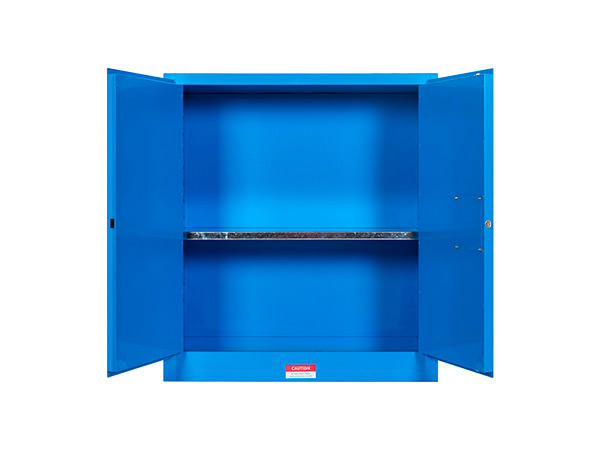A safety cabinet is a prefabricated piece of equipment specially designed to store hazardous chemicals in mobile containers, protecting their contents in the event of fire, for a set period of time and meeting the safety requirements of the current ITC (International Trade Centre) and APQ (656/2017) regulations. This type of cabinet is an efficient and comfortable solution for storing a wide range of products and materials. Security cabinets have a much greater capacity than safes, enabling the safe storage of large quantities of documents, valuables or sensitive materials that need to be well protected. The use of security cabinets guarantees high resistance to theft and assault and, combined with fireproof materials, can offer complete protection against theft and fire.
Safety cabinet regulations
The safe storage of hazardous substances is a crucial issue for any company, as correct storage helps to prevent and avoid potential accidents, while ensuring the best possible hygienic conditions in the workspace, as well as compliance with current legislation, both in terms of risk prevention and RD 379/2001 APQ.
The storage of flammable substances in safety cabinets is governed by European standard EN 14470-1. This standard was approved by the European Union on April 1, 2004 and accepted by AENOR in January 2005. The tests and constructive characteristics of enclosures have been revised and, in certain details, specified in this regulation. According to this standard, the fire resistance of a safety cabinet must be verified by a fire test (type test). In addition to EN 14470-1, the construction requirements and specifications for carrying out the above-mentioned tests are described in due course. In this way, fire-fighters’ response times and the implementation of safety protocols can be carried out safely and without risk to people and the storage site.
Some regulatory specifications
- According to APQ regulations, the maximum storage quantity allowed inside each cabinet is determined by the hazardous nature of the liquid to be stored. For highly flammable products (e.g. H224 and H225 solvents and paints), the maximum quantity to be stored is 250 liters per cabinet. For less flammable products (type H226), the maximum quantity is 500 liters per cabinet.
- Safety cabinets for flammable products are those with a fire resistance rating of 90 minutes, Type 90 according to European standard UNE EN 14470-1.
- It’s essential to prevent operators from breathing noxious or toxic substances. That’s why, although QPA regulations don’t always require forced ventilation, it is an important safety and occupational risk prevention measure.
What features must a safety cabinet have to store chemicals?
- Comply with APQ rules
- Retention bins must be integrated and made of a material suitable for the substance to be stored.
- They must be equipped with automatic opening and closing systems.
- An air extraction system.
- A safety closure to prevent access by unauthorized personnel.
- High fire resistance, in compliance with UN EN 14470-1.
- Approved for use in ATEX zones.
What can Kalstein offer you?
Kalstein is a MANUFACTURER of medical and laboratory equipment of the highest quality and technology at the best PRICES on the market. You can therefore make your PURCHASE with us in complete confidence, knowing that you are benefiting from the service and advice of a company that specializes in the sector and is committed to providing you with safe, economical and efficient options to perform your duties in the right way. This time, we present our 416-gallon explosion-proof cabinet YR053403 // YR053403-2. This new team features:
- Environmentally-friendly, highly insulated spraying.
- Three-point, double-locking hitch
- Adjustable laminate with high load-bearing capacity
- Electrostatic grounding, improved safety
- Three colors, each with its own special features.
- Safe, reliable double locking: two locks, two handlers. Double security, lock and cabinet lock, standardized management, safety factor
For more information, please visit: HERE

